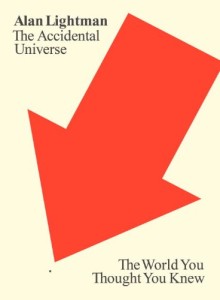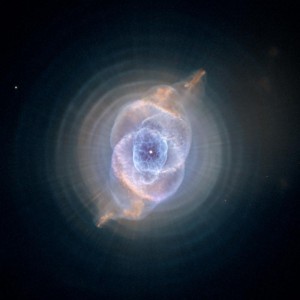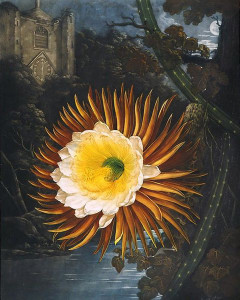Alan Lightman on Our Yearning for Immortality and Why We Long for Permanence in a Universe of Constant Change
LITERATURE, 26 May 2014
Maria Popova, Brain Pickings – TRANSCEND Media Service
A heartening perspective on mortality by way of the physics of the cosmos and the poetics of the night-blooming cereus cactus.
 “We suffer from a hallucination, from a false and distorted sensation of our own existence as living organisms,” Alan Watts wrote in contemplating how our ego keeps us separate from the universe. “It is almost banal to say so,” Henry Miller observed, “yet it needs to be stressed continually: all is creation, all is change, all is flux, all is metamorphosis.” But banal as it may be, it is also intolerably discomfiting to accept, which is why we retreat into our hallucination — we resist change, we long for immortality, and we cling to the notion of the self, despite its ever-changing essence, as anxious assurance of our own permanence in an impermanent universe.
“We suffer from a hallucination, from a false and distorted sensation of our own existence as living organisms,” Alan Watts wrote in contemplating how our ego keeps us separate from the universe. “It is almost banal to say so,” Henry Miller observed, “yet it needs to be stressed continually: all is creation, all is change, all is flux, all is metamorphosis.” But banal as it may be, it is also intolerably discomfiting to accept, which is why we retreat into our hallucination — we resist change, we long for immortality, and we cling to the notion of the self, despite its ever-changing essence, as anxious assurance of our own permanence in an impermanent universe.
Alan Lightman, a cosmic poet of the ages — something at least partially attested to by his position as MIT’s first professor to receive dual appointments in science and the humanities — explores this despairing paradox in “The Temporary Universe,” the third essay in his altogether mind-expanding collection The Accidental Universe: The World You Thought You Knew (public library), which also gave us Lightman on science and spirituality and how dark energy sheds light on why we exist.
Lightman begins with the bittersweet beauty of a deeply human rite of passage: As he walked his eldest daughter down the aisle, “radiant in her white dress, a white dahlia in her hair,” she asked to hold his hand and something else, something heavy yet inescapable, gripped Lightman’s heart. He writes:
It was a perfect picture of utter joy, and utter tragedy. Because I wanted my daughter back as she was at age ten, or twenty. As we moved together toward that lovely arch that would swallow us all, other scenes flashed through my mind: my daughter in first grade holding a starfish as big as herself, her smile missing a tooth; my daughter on the back of my bicycle as we rode to a river to drop stones in the water; my daughter telling me the day after she had her first period. Now she was thirty. I could see lines in her face.
Aware of both the absurdity and the humanity of his feelings in that moment, Lightman considers the root of that wistfully familiar existential unease:
I don’t know why we long so for permanence, why the fleeting nature of things so disturbs. With futility, we cling to the old wallet long after it has fallen apart. We visit and revisit the old neighborhood where we grew up, searching for the remembered grove of trees and the little fence. We clutch our old photographs. In our churches and synagogues and mosques, we pray to the everlasting and eternal. Yet, in every nook and cranny, nature screams at the top of her lungs that nothing lasts, that it is all passing away. All that we see around us, including our own bodies, is shifting and evaporating and one day will be gone. Where are the one billion people who lived and breathed in the year 1800, only two short centuries ago?
Nature, he argues, is unambiguous in her message — from the mayflies that “drop by the billions within twenty-four hours of birth” to the glaciers that “slowly but surely grind down the land” to our own flesh, just as slowly and surely sagging into agedness, order, with all its comforting familiarity, steadily descends into chaos. It is, after all, one of the laws of the universe:
Physicists call it the second law of thermodynamics. It is also called the arrow of time. Oblivious to our human yearnings for permanence, the universe is relentlessly wearing down, falling apart, driving itself toward a condition of maximum disorder. It is a question of probabilities. You start from a situation of improbable order, like a deck of cards all arranged according to number and suit, or like a solar system with several planets orbiting nicely about a central star. Then you drop the deck of cards on the floor over and over again… Order has yielded to disorder. Repeated patterns to change. In the end, you cannot defeat the odds. You might beat the house for a while, but the universe has an infinite supply of time and can outlast any player.

The Cat’s Eye Nebula, one of the first planetary nebulae discovered, from ‘Hubble: Imaging Space and Time.’
Lightman offers an example elemental to our embodied existence — our skeletal muscles:
With age, muscles slacken and grow loose, lose mass and strength, can barely support our weight as we toddle across the room. And why must we suffer such indignities? Because our muscles, like all living tissue, must be repaired from time to time due to normal wear and tear. These repairs are made by the mechano growth factor hormone, which in turn is regulated by the IGF1 gene. When that gene inevitably loses some tines … Muscle to flab. Vigor to decrepitude. Dust to dust.
And yet something about the human experience — the human condition, with its implied pathology of consciousness — causes us to tense against this natural progression with anguishing anxiety rather than resting into it with calm acceptance:
We continue to strive for youth and immortality, we continue to cling to the old photographs, we continue to wish that our grown daughters were children again.
This resistance to change, which takes on the proportions of agonizing aversion, isn’t reserved just for our physical bodies — we loathe the redesign of our favorite sites, the reorganization of our companies, the disposal of our childhood toys. This is also, perhaps, why a gobsmacking percentage of people refuse to believe Earth is more than 6,000 years old — something about the notion of all that has been and no longer is feels unbearable in its implicit testament to our own impending non-existence. And yet change is in the fundamental building block of Earth’s DNA. Lightman traces this back to the stars:
Over its 4.5-billion-year history, our own planet has gone through continuous upheavals and change. The primitive Earth had no oxygen in its atmosphere. Due to its molten interior, our planet was much hotter than it is now, and volcanoes spewed forth in large numbers. Driven by heat flow from the core of the Earth, the terrestrial crust shifted and moved. Huge landmasses splintered and glided about on deep tectonic plates. Then plants and photosynthesis leaked oxygen into the atmosphere. At certain periods, the changing gases in the air caused the planet to cool, ice covered the Earth, entire oceans may have frozen. Today, the Earth continues to change. Something like ten billion tons of carbon are cycled through plants and the atmosphere every few years — first absorbed by plants from the air in the form of carbon dioxide, then converted into sugars by photosynthesis, then released again into soil or air when the plant dies or is eaten. Wait around a hundred million years or so, and carbon atoms are recycled through rocks, soil, and oceans as well as plants.
[…]
At some point in the future, new stars will cease being born. Slowly but surely, the stars of our universe are winking out. A day will come when the night sky will be totally black, and the day sky will be totally black as well. Solar systems will become planets orbiting dead stars. According to astrophysical calculations, in about a million billion years, plus or minus, even those dead solar systems will be disrupted from chance gravitational encounters with other stars. In about ten billion billion years, even galaxies will be disrupted, the cold spheres that were once stars flung out to coast solo through empty space.
In his characteristically elegant trapeze act of swinging between science and the humanities, Lightman turns to the Buddhist notion of anicca to make sense of our paradoxical predicament in the face of such cosmic evidence:
In Buddhism, anicca is one of the three signs of existence, the others being dukkha, or suffering, and anatta, or non-selfhood. According to the Mahaparinibbana Sutta, when the Buddha passed away, the king deity Sakka uttered the following: “Impermanent are all component things. They arise and cease, that is their nature: They come into being and pass away.” We should not “attach” to things in this world, say the Buddhists, because all things are temporary and will soon pass away. All suffering, say the Buddhists, arises from attachment.
Wryly adding that if he could “detach” from his daughter, he might feel better, Lightman considers the uncomfortably palpitating heart of the matter — the choice each of us has to make in contemplating change and eternity:
To my mind, it is one of the profound contradictions of human existence that we long for immortality, indeed fervently believe that something must be unchanging and permanent, when all of the evidence in nature argues against us. I certainly have such a longing. Either I am delusional, or nature is incomplete. Either I am being emotional and vain in my wish for eternal life for myself and my daughter (and my wingtips), or there is some realm of immortality that exists outside nature.
The first option only offers one possible course of action — come to terms with it, and move on. It’s an unfair proposition, no doubt, but not a particularly difficult one — for, as Lightman puts it, “the human mind has a famous ability to create its own reality.” The second — the idea of nature’s incompleteness, perhaps even negligence — is the hotbed of many religious explanations. Lightman, who explored the tension between science and spirituality with unparalleled grace in another essay, writes:
Despite all the richness of the physical world — the majestic architecture of atoms, the rhythm of the tides, the luminescence of the galaxies—nature is missing something even more exquisite and grand: some immortal substance, which lies hidden from view. Such exquisite stuff could not be made from matter, because all matter is slave to the second law of thermodynamics. Perhaps this immortal thing that we wish for exists beyond time and space. Perhaps it is God. Perhaps it is what made the universe.
Of these two alternatives, I am inclined to the first. I cannot believe that nature could be so amiss. Although there is much that we do not understand about nature, the possibility that it is hiding a condition or substance so magnificent and utterly unlike everything else seems too preposterous for me to believe. So I am delusional. In my continual cravings for eternal youth and constancy, I am being sentimental. Perhaps with the proper training of my unruly mind and emotions, I could refrain from wanting things that cannot be. Perhaps I could accept the fact that in a few short years, my atoms will be scattered in wind and soil, my mind and thoughts gone, my pleasures and joys vanished, my “I-ness” dissolved in an infinite cavern of nothingness. But I cannot accept that fate even though I believe it to be true. I cannot force my mind to go to that dark place. “A man can do what he wants,” said Schopenhauer, “but not want what he wants.
To alleviate the weight of this insurmountable impossibility, Lightman proposes that we should reframe the question rather than lament the answer:
If against our wishes and hopes, we are stuck with mortality, does mortality grant a beauty and grandeur all its own? Even though we struggle and howl against the brief flash of our lives, might we find something majestic in that brevity? Could there be a preciousness and value to existence stemming from the very fact of its temporary duration? And I think of the night-blooming cereus, a plant that looks like a leathery weed most of the year. But for one night each summer its flower opens to reveal silky white petals, which encircle yellow lacelike threads, and another whole flower like a tiny sea anemone within the outer flower. By morning, the flower has shriveled. One night of the year, as delicate and fleeting as a life in the universe.
The Accidental Universe is absolutely spectacular in its entirety, each essay its own poetic whirlwind of physics and philosophy. Complement it with another Alan — Watts — on our illusory reality.
________________________________
Brain Pickings is the brain child of Maria Popova, an interestingness hunter-gatherer and curious mind at large obsessed with combinatorial creativity who also writes for Wired UK and The Atlantic, among others, and is an MIT Futures of Entertainment Fellow. She has gotten occasional help from a handful of guest contributors.
Go to Original – brainpickings.org
DISCLAIMER: The statements, views and opinions expressed in pieces republished here are solely those of the authors and do not necessarily represent those of TMS. In accordance with title 17 U.S.C. section 107, this material is distributed without profit to those who have expressed a prior interest in receiving the included information for research and educational purposes. TMS has no affiliation whatsoever with the originator of this article nor is TMS endorsed or sponsored by the originator. “GO TO ORIGINAL” links are provided as a convenience to our readers and allow for verification of authenticity. However, as originating pages are often updated by their originating host sites, the versions posted may not match the versions our readers view when clicking the “GO TO ORIGINAL” links. This site contains copyrighted material the use of which has not always been specifically authorized by the copyright owner. We are making such material available in our efforts to advance understanding of environmental, political, human rights, economic, democracy, scientific, and social justice issues, etc. We believe this constitutes a ‘fair use’ of any such copyrighted material as provided for in section 107 of the US Copyright Law. In accordance with Title 17 U.S.C. Section 107, the material on this site is distributed without profit to those who have expressed a prior interest in receiving the included information for research and educational purposes. For more information go to: http://www.law.cornell.edu/uscode/17/107.shtml. If you wish to use copyrighted material from this site for purposes of your own that go beyond ‘fair use’, you must obtain permission from the copyright owner.
